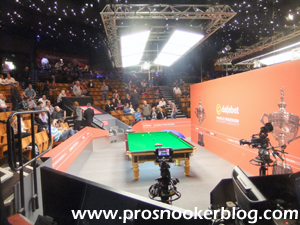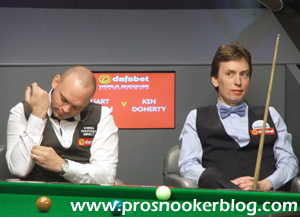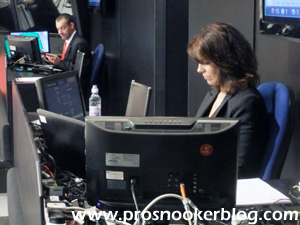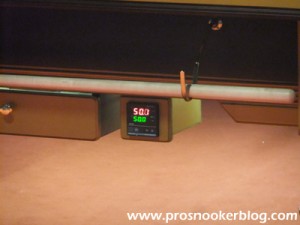
While I am now fortunate enough to have been coming to watch snooker at the Crucible Theatre for a decade, I appreciate that there will be many of you who have never visited snooker’s most famous venue. Indeed, some will never have seen tournament snooker live before and perhaps wonder whether it is even worth it, with the extensive coverage and angles shown on TV these days.
For that reason, in my quest to bring people closer to the action, I thought that it would be nice to put a post together on the little things that you don’t see from watching on television, some of them unique to this place, some not…
This year I have again been fortunate enough to have media access here at the Crucible this year and one of the perks to come with that access is that I am also allowed to sit in the ‘media seats’ at the black end of the table behind the television cameras.
As well as having a good view of the action, it certainly gives me a different perspective to what goes on in the arena, both during a match and beforehand.
The most obvious thing that anyone watching snooker here will realise is just how small the venue is, with little room for anyone on the floor to move around. I noticed referee Brendan Moore catching the hoardings at the side of the table within a few shots of the tournament opener between Ronnie O’Sullivan and Robin Hull, while Neil Robertson in particular frequently walks back into the wall at the two-table stage.

One thing that I do particularly enjoy about watching live snooker, not just here at the Crucible but anywhere, is that you get to see the reactions of the players to every shot, both those at the table and those in their chair. Often on television it is difficult to see whether a player has left the cue ball where they had intended, but in the arena you only have to look at the body language of the player to instantly know the answer.
Some players are more expressive than others, Ali Carter and Michael Holt among those who most wear their hearts on their sleeves, while even Xiao Guodong showed signs of emotion, generally towards the black end of the table out of sight of opponent Carter, presumably so as not to give him any encouragement.
I have always found it fascinating though to watch the player not at the table. The most mentally challenging aspect of snooker for a player has to be the fact that when your opponent is at the table, there is nothing at all that you can do and every player handles that differently.
Some will sit there and betray as little emotion as possible, some will watch the table intently, or look up at the television coverage on the arena monitors for the spectators, while others appear to almost completely disengage from what their opponent is doing and look at something else, for example across the arena to the next table.

Another aspect of the ‘show’ that stands out to me when watching live at the Crucible is that of the referees, as I think only from that position behind the table is it possible to realise how much work they do and how good they are at their job. During the first few frames of the match between Ricky Walden and Kyren Wilson earlier in the tournament, I kept a close eye on referee Brendan Moore and it was interesting to see all of the little things that go on that you do not see.
On the face of it, beyond knowing the rules and being able to concentrate, you could be forgiven for thinking that there is not much else to their job, but in reality there are all sorts of other things that they have to be aware of.
One is how they interact with the cameramen, particularly at the two-table stage when there is so little room for manoeuvre. For example when a player is playing a shot up to the baulk end of the table, the referees will have to navigate around the back of the television cameras behind the player to take up a position that they need, without both disturbing the player, tripping over the array of cables from the cameras and if possibly, without obstructing the view of the camera. Not as easy as it sounds.
That said, there are referees who will use the cameras to their advantage, I have noticed this in particular with Moore, who on occasions when snookers are laid and his view obstructed by the player, he will use the viewfinder on the camera as another way to see the position of the balls.

Another big, if understated job for the referees is crowd management, both on their side of the dividing wall and also on the other. For example, when the match of the other side reaches the end of a frame, or its mid-session interval, it is not uncommon to see the referee go round the wall to remind the crowd that there is another match still going on. also when a player is down on a shot and a referee cannot speak, it usually only takes a visual sign such as a raise of the hand, for them to communicate a visual ‘shush’ so to speak!
With other distractions, such as overly loud earpieces (always a problem), mobile telephones going off, people unwrapping boiled sweets at inappropriate times, taking photographs during play, there are so many potential disturbances from the crowd that a referee has to always be aware of. While these are applicable at most venues, the proximity of the crowd to the table here only serves to magnify the potential for something to happen.
There are lots of other little things that are noticeable too, for example how the referees will quietly remove reds from the pockets towards the latter stages of frames and place them into more empty pockets so as to avoid the balls from falling onto the floor. Another one is how the referees will almost strategically plan during a break a moment at which they can sneak to the back to have a sip of water without missing anything on the table.

As well as the referee out in the arena, there is of course also the ‘marker’, who you are most likely to see on television when the scoreboard monitor is used to assist the referee. Earlier this week, during the final session of the match between Ali Carter and Mark Selby, I was able to sit up with Leo Scullion and watch the match from that vantage point, where it was something of an eye-opener to see exactly what the marker has to do, as also explained by Michaela Tabb within my recent article here.
The other interesting thing that I noticed was that from that viewpoint I could hear every word of commentary from John Virgo, whether the door to the commentary box was closed or whether the commentators are always audible from that position I am not sure.
Having mentioned the cameramen in passing earlier, their work is something that you definitely do not appreciate until you have sat behind them in the arena. Particularly at the two-table set-up with room at a premium, it is amazing to see how close they get to the table and how they work to bring you the best coverage possible, without distracting the players and more to the point, tripping over the many cables behind them.

When any televised tournament is in progress, one of my articles on this blog that always sees a lot of views is one that I wrote a couple of years ago here, addressing the issue of what the purpose of the digital display at the bottom of the black end of the snooker table is.
As explained within that article, the display shows the temperature of the under table heaters, set at 50C in order to bring the playing surface up to approximately 21C.
Interestingly, the worth of under table heating and whether or not they contribute to the amount of kicks that we have seen in recent years is something that has been debated on Twitter in recent days, Shaun Murphy amongst those advocating a ban on the heating, but whether that happens remains to be seen.
New to the tournament for the final five days this week is the in-arena BBC studio, which has replaced the photography box that had previously been in situ over on what was table one.

The merits of the new studio are up for debate, certainly I do not think that it adds a great amount to the tournament, while the potential for distraction from what is not a soundproof area clearly exist. As a spectator, it was hard to resist looking in occasionally, as Stephen Hendry appeared to be glued to the action between Neil Robertson and Mark Selby today, while Steve Davis was occupied with something else.
Finally, one trick at the two-table stage of the event that any spectator needs to know is that to keep abreast of what is going on over on the other side of the curtain, you can do no better than to look up into the reflection on the commentary box, in which you can generally see the business end of the table!
All of these examples are just a few of the things that make live snooker and in particular Crucible snooker unique as a spectator and why I would recommend that anyone thinking about booking tickets for next year’s event (on sale next Tuesday), should do everything possible to try and make it here.
